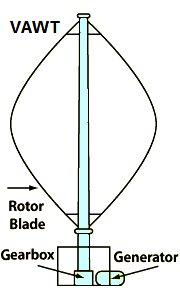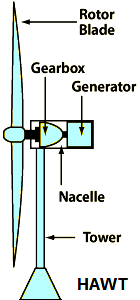THE GUIDE TO WIND POWER TURBINES FOR YOUR HOME |
|||||||
<---------------------------------------------------------------------------------------------------------------------------------> |
|||||||
THE BASIC FACTSIn a broad sense, a wind turbine is any device that converts the kinetic energy of the moving air into other usable forms of energy. However, nowadays this term usually refers to an electro-mechanical system that converts the wind power to electricity. Such a system was first built in 1888 in US by Brush Electric and since then is being used widely for generating electricity. If the air motion is converted to mechanical energy that is used directly by machinery, such as a pump or grinding stones, such a machine is more often referred to as a windmill.   TYPES OF WIND TURBINESThere are two main types of turbines based on the axis on which they rotate: horizontal axis ("propeller-type") and vertical-axis. Both styles have their pros and cons and both are used in home wind generators. The main advantages of horizontal axis wind turbines (HAWT) are their higher efficiency and ability to self start. Their main disadvantages are the requirement of tall towers, which are difficult to transport and install, and the necessity to constantly align in the direction of the airflow. Vertical-axis turbines (VAWT) do not have to be pointed into the wind, so their alternator and gearbox can be placed at the bottom of the tower. There are two brands of VAWT: Darrieus ("egg-beater") and Savnoius (S-type). Both are relatively low-efficient. In addition to this, the Darrieus type is not self-starting. On the positive side, a small VAWT can be mounted on a home's flat rooftop, since the building generally redirects an air flow over the roof and this can increase its speed at the turbine. Nevertheless, because of lower efficiency of vertical systems, HAWTs are more common nowadays. You can find more details including pros and cons of each type in this guide. HOW THEY WORKThe picture below shows the inside of a large wind turbine. It is a so-called upwind HAWT. Upwind means it is pointed against the airflow. The rotors of most HAWT are located upwind of the tower. The main rotor shaft and alternator at the top of a tower must change orientation when the air current changes direction. To support the system as it swivels on its tower such models use sealed bearing called the yaw bearing (the swiveling motion is called yawing). Upwind models have yaw drive to orient the rotor into the wind. Downwind models don't need a yaw drive: the wind itself turns the rotor away from moving air. To connect the output terminals of the moving alternator to the fixed cables that carry the electric current down the tower to the home, most models use copper alloy slip rings. The moving part of the turbine has a set of graphite brushes that ride on the slip rings as the turbine yaws. The anemometer monitors the air speed and sends the data to the controller, which starts up the system at a certain minimum wind speed (typically 8 to 16 mph) and shuts off the machine at high winds (typically above 50 mph). The rotor assembly includes the blades that convert the kinetic energy of moving air to rotational shaft energy. Most modern small wind turbines suitable for homes have two to five blades. The rotor is connected to the main shaft of the alternator. The generator (alternator) converts the kinetic energy of the spinning shaft into electrical energy. It contains one or several permanent magnets that spin inside or around stationary coils. When the air stream turns the blades, they spin the shaft with magnets, which creates an alternating magnetic field in the coils. This field in turn induces AC voltage according to Faraday's induction law. FACTORS TO CONSIDERDifferent manufacturers obviously use different designs. Here are some lesser known facts to consider. In small wind generators for home use, the blade rotor normally drives the magnet rotor directly. Higher power systems (>10kW) usually have a gearbox that converts the low-speed high-torque incoming rotation of the blade rotor to high-speed low-torque rotation of the alternator rotor. However, gearboxes affect power longevity of the residential models: a life span of a HAWT gearbox may be just a few years. In my view, you should prefer a direct drive. Alternators in the small systems produce voltage whose frequency and amplitude varies wildly with the wind intensity. Most models provide 3-phase AC output. To be usable, it has to be rectified and then converted into a standard residential single-phase sinewave with stabilized amplitude and frequency. The rectification is done by a bridge rectifier. It can also be accomplished by a commutator that reverses the electric current direction between the rotor and the load. All turbines should have some means of stopping them. The drawing above shows a mechanical brake. Many small devices can stop by folding the tail. In some designs the blades have a special geometry, so that at a certain high air velocity they start to stall. Small turbines may also have electrical braking: a multi-pole switch disconnects the load and shorts together all the three phases of the alternator. However this method does not always work- in strong winds the rotor may continue spinning even with shorted coils, which can damage the whole system. Keep in mind that rotating blades and gears make noise. Most states mandate maximum noise level, typically at 10dB above the background. There are some horizontal models with a ring that goes around the blades. This ring lowers the noise level. When you are consider various wind turbines for the home, you obviously want to know how much electricity they can generate in your application. Unfortunately, you can't just use their advertised wattage. The problem is that different manufacturers can rate their devices at different air speeds (unless they follow AWEA voluntary standard). Therefore the rated power by which the models are listed and advertised does not let you compare apples and apples. What you should consider when you do the comparison are the "swept area" and efficiency. The output power of a wind generator is primarily a function of these two characteristics. If you know them, you can estimate the amount of watts a particular device can produce for your home at a given air speed by using our calculator. |
|
||||||
<---------------------------------------------------------------------------------------------------------------------------------> | |||||||
